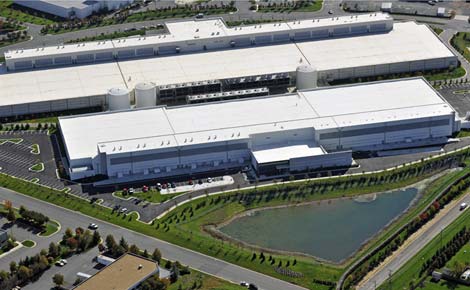Building Smaller: DFT Adopts New Data Center Design
DuPont Fabros Technology will continue to build some of the largest data centers on the planet. But it will do so in smaller chunks. The developer says it is finalizing a new design that will deploy new wholesale data center space in smaller phases of about 4.5 megawatts.
February 11, 2013

DFT-ACC5-ACC6
Here's an aerial view of the enormous ACC5 and ACC6 data centers developed by DuPont Fabros. The company says it will build future facilities in smaller phases. (Photo: DuPont Fabros Technology)
DuPont Fabros Technology will continue to build some of the largest data centers on the planet. But it will do so in smaller chunks.
The developer says it is finalizing a new design that will deploy new wholesale data center space in smaller phases of about 4.5 megawatts. DuPont Fabros (DFT) will use the new approach in its ACC7 data center project in Ashburn, Virginia, which is scheduled to begin construction this spring.
The company previously has deployed up to 18 megawatts of new space at a time, building massive facilities sized at 36 megawatts and more than 400,000 square feet in just two phases. DuPont Fabros maintained this practice even as most of its competitors in the wholesale data center market rolled out new space in smaller installments, sometimes as little as 1.1 megawatts of critical power at a time. Building big allowed DFT to make large deals with fast-growing "super-wholesale" clients like Facebook, Rackspace, Apple and Microsoft. But it also involved slightly more risk, especially in enterprise markets where companies take longer to evaluate their data center options.
The new design will allow DuPont Fabros to spread out its construction budget over a longer period. Perhaps most importantly, it will take some pressure off the leasing effort, averting scenarios in which DFT is marketing vast amounts of space in markets with uneven pace of leasing.
Smaller Increments, Similar Economics
As an example, the company currently has about 12 megawatts of space available in its NJ1 data center in Piscataway. It leased about 1 megawatt of space in 2012, and has not included any additional leasing revenue from NJ1 in its revenue guidance for 2013.
"We're now able to build out in smaller incremental megawatts instead of the full phase," said Hossein Fateh, President and CEO of DuPont Fabros. "This enables us to match demand and supply, while decreasing our capital expenses and carrying costs during lease up. The amount of pre-leasing and tenant demand will determine how many incremental megawatts we will develop and deliver."
DFT said its goal is to retain the favorable economics that are available when building at scale. The company currently spends about $8.5 million per megawatt to build data center space, including capitalized interest costs. The new design will retain the core concepts used in DuPont Fabros' previous new builds, including an ISO parallel power design that allows load sharing across multiple data halls while allowing each tenant to be isolated from electrical faults, effectively providing a dedicated electrical service.
Allows for Higher Voltages
"The ISO parallel system will continue to be a main feature of our next-generation data center design," said Scott Davis executive vice president of operations for DuPont Fabros. "We have devised greater flexibility for the facility to be constructed in a more modular fashion, allowing for multiple phases of construction and logical building blocks sized to better match our expected demand.
"Industry trends and new product offerings afford new opportunities to further enhance our designs and operational effectiveness," Davis continued. "Additionally, we have ongoing collaboration with our clients, and we have taken their requirements into consideration with our new design."
Those requirements include higher distribution voltage to computer rooms, which has been a facet of designs for Facebook, a major tenant for DuPont Fabros. Another large tenant, Rackspace, is also implementing elements of Open Compute designs optimized for higher voltage to the rack.
The physical space within the data center may also be organized differently. "There will also be provisions for air-conditioners and power distribution units, which are normally housed in the computer room, to be housed in segregated equipment galleries for clients with high security requirements," said Davis. "Our design process is still under way, and these elements are subject to change until we complete the final design."
About the Author
You May Also Like







